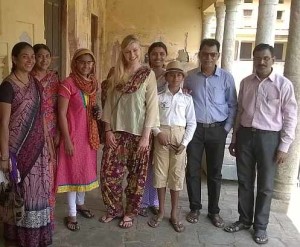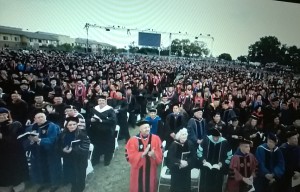Falling Leaves and Good-byes
 We are now back in California. Saying good-bye to our friends and our adopted home was profoundly sad. As we were packing up and making preparations for our departure, we noticed that the trees along the stream that we see through our window were starting to change color. Autumn was on its way.
We are now back in California. Saying good-bye to our friends and our adopted home was profoundly sad. As we were packing up and making preparations for our departure, we noticed that the trees along the stream that we see through our window were starting to change color. Autumn was on its way.
My husband gave me permission to copy what he wrote after returning from a walk:
It is now time for this crop of leaves to fall. Yet they do not fall in vain. Slowly, as they blend with the soil of our hearts, they will in unseen ways both protect and nourish, so that in due time, that soil will produce a new crop of leaves and fruit, more abundant, sweeter and higher than before, all on a trunk that is made stronger by one more ring of winter. My leaves are yours, oh God. Do with them what is best. 
Through the seasons, it was amazing to see the trees go from bare brown sticks in the winter to spring-green buds, then leafy summer foliage. Now the leaves are turning gold and brown, and falling to the ground. Do trees ever feel reluctant to release their leaves? Letting go can be hard, and I feel the grief of all that I’m releasing, all the good-byes that I’m saying. But new leaves can’t grow until the old ones are gone. And those brown, decaying leaves nourish the soil for the growth to come in the next season. But for this season, my branches will be bare.
Posted in Uncategorized and tagged fall leaves by Lisa
Masala Lesson
 Mmmm… doesn’t it smell good? We love our upstairs apartment, but one of the downsides of living above an Indian family is the scent of masala that drifts up the stairwell each afternoon as dinner is prepared! Our mouths start watering, and then whatever simple dish I’m throwing together in my own kitchen just isn’t as satisfying. One of my local favorites is a dish Indians call “tomato paneer.” Since we will soon be leaving here to return to California, I asked our landlord’s wife, Raja, to show me how to make it.
Mmmm… doesn’t it smell good? We love our upstairs apartment, but one of the downsides of living above an Indian family is the scent of masala that drifts up the stairwell each afternoon as dinner is prepared! Our mouths start watering, and then whatever simple dish I’m throwing together in my own kitchen just isn’t as satisfying. One of my local favorites is a dish Indians call “tomato paneer.” Since we will soon be leaving here to return to California, I asked our landlord’s wife, Raja, to show me how to make it.
Paneer is a locally-made cheese with a mild flavor, similar to ricotta, only stiffer.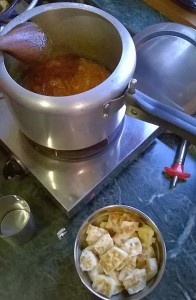 The first step is to cut it into pieces and fry it in oil to a light golden-brown. Then Raja set it aside and collected her spices. She sautéed chopped onion and garlic in oil and then added the assorted spices—her own masala blend. One of the secrets to Indian-style cooking is to let the spices mix and sizzle in the oil for quite a while until their full flavor is released. She added water and chopped tomatoes, and while the tomatoes were cooking, she mashed them with her wooden spoon and let the whole mixture boil down to a thick, aromatic sauce. The last step was to add the paneer and a little salt.
The first step is to cut it into pieces and fry it in oil to a light golden-brown. Then Raja set it aside and collected her spices. She sautéed chopped onion and garlic in oil and then added the assorted spices—her own masala blend. One of the secrets to Indian-style cooking is to let the spices mix and sizzle in the oil for quite a while until their full flavor is released. She added water and chopped tomatoes, and while the tomatoes were cooking, she mashed them with her wooden spoon and let the whole mixture boil down to a thick, aromatic sauce. The last step was to add the paneer and a little salt.
 We all ate together, spooning the paneer and sauce onto plates heaped with rice. We’ve learned pretty well how to mix the rice and sauce together with our fingers and plop it into our mouths with only a little mess. So tasty! I’ll bring this recipe back to California, and see if I can find an Indian shop that sells paneer. Would you like to come over and try it, sitting on the floor with us and eating with our hands? Along with the recipe, I’m bringing back fragrant memories of the friendship of Raja and her family, packed safely in my heart.
We all ate together, spooning the paneer and sauce onto plates heaped with rice. We’ve learned pretty well how to mix the rice and sauce together with our fingers and plop it into our mouths with only a little mess. So tasty! I’ll bring this recipe back to California, and see if I can find an Indian shop that sells paneer. Would you like to come over and try it, sitting on the floor with us and eating with our hands? Along with the recipe, I’m bringing back fragrant memories of the friendship of Raja and her family, packed safely in my heart.
Posted in Uncategorized and tagged cooking by Lisa
I Want to Catch Fire
I’d never seen a kingfisher until this spring.  These waterbirds can be spotted in our area during the warm months, near the lake where they can keep an eye open for fish. Someday I may get to see one “catch fire.” This is what Gerard Manley Hopkins writes about in one of my favorite poems, below. His image is of the bird, which is mostly blue with a red-orange breast, diving for a fish, and as it does, the sun flashing brilliantly from its feathers. The bird is doing what it was created to do, and as it does, we witness an instant of transcendent beauty.
These waterbirds can be spotted in our area during the warm months, near the lake where they can keep an eye open for fish. Someday I may get to see one “catch fire.” This is what Gerard Manley Hopkins writes about in one of my favorite poems, below. His image is of the bird, which is mostly blue with a red-orange breast, diving for a fish, and as it does, the sun flashing brilliantly from its feathers. The bird is doing what it was created to do, and as it does, we witness an instant of transcendent beauty.
As kingfishers catch fire, dragonflies draw flame;
As tumbled over rim in roundy wells
Stones ring; like each tucked string tells, each hung bell’s
Bow swung finds tongue to fling out broad its name;
Each mortal thing does one thing and the same:
Deals out that being indoors each one dwells;
Selves—goes its self; myself it speaks and spells,
Crying What I do is me; for that I came.
I say more: the just man justices;
Keeps grace: that keeps all his goings graces;
Acts in God’s eye what in God’s eye he is—
Christ. For Christ plays in ten thousand places,
Lovely in limbs, and lovely in eyes not his
To the Father through the features of men’s faces.
 As birds, bells, and dragonflies do what they were created for, they display brief but heavenly beauty and joy. I have had this experience, too—have you? There have been times when I have done work, sometimes extremely challenging work, that I sense “speaks and spells myself.” At those times in the midst of my toil, I sense in my heart that this is what I was uniquely made for, this is my vocation, this is why I came.
As birds, bells, and dragonflies do what they were created for, they display brief but heavenly beauty and joy. I have had this experience, too—have you? There have been times when I have done work, sometimes extremely challenging work, that I sense “speaks and spells myself.” At those times in the midst of my toil, I sense in my heart that this is what I was uniquely made for, this is my vocation, this is why I came.
Moments like that have come for me when I’ve been teaching English, or writing, or ministering to women. The story about Shahaz from a few weeks ago was one such moment. At those times, Christ plays in this particular place through me, and I feel special joy. The kingfisher is a decorative motif we see around here, often painted on boats on the lake. It reminds me to keep watching, like that sharp-eyed bird, for my particular moment to dive, to speak, to ring, to catch fire.
Posted in Uncategorized and tagged kingfisher by Lisa
Shoes on the Doorstep
Here is one of the first things we learned upon arriving in North India, and we learned it before we had even set foot inside our landlord’s door:
This rule wasn’t a big surprise, as we had gotten used to slipping our sandals off at the door of our home in West Africa. We had carried the tradition back over the ocean to our apartment in Pasadena, where we had a spot just inside the front door for our shoes.
In fact, we have learned that the shoes-stay-outside rule is followed in most cultures of the world, especially non-Western ones. In many places, like where we live now, animals such as cows, sheep, and chickens populate the out-of-doors, and we’d rather not bring any unpleasant traces of them into our homes. Carpets are expensive, and carpet-cleaning is done by hand. In traditional cultures where honor is important, guests show respect for their host and his home by entering with bare feet.
I’ve also learned to glean information from the shoes I see outside the door.  When I go out to visit, I can often guess whether my neighbor is at home by whether I see her shoes on the front step. Returning home to our apartment the other day, I was greeted by the cheerful sight of four pairs of fancy girls’ sandals outside the door; our landlord’s cousin was visiting with her four daughters! I imagine that my long American-style flip-flops were happy to join them on the doorstep, where they have come to feel at home.
When I go out to visit, I can often guess whether my neighbor is at home by whether I see her shoes on the front step. Returning home to our apartment the other day, I was greeted by the cheerful sight of four pairs of fancy girls’ sandals outside the door; our landlord’s cousin was visiting with her four daughters! I imagine that my long American-style flip-flops were happy to join them on the doorstep, where they have come to feel at home.
Posted in Uncategorized and tagged shoes by Lisa
A Touch from Me, a Touch from Him
Two weeks ago I went by to visit my friend Shahaz, and found her in bed with severe back pain. Normally cheerful and animated, her face was pale and wore an exhausted expression. She slowly sat up and I began massaging her lower back, which seemed to give her some relief. Then I told her I was going to pray for her in Jesus’ name, and she gave me a small nod. My language isn’t good enough for a long prayer, but with my hand still on her back, I asked God to heal her and take away the pain, and to give her and her family peace. And I ended with, “in the name of Jesus” in the local language. She smiled, and after rubbing her back a little more, I left.
A few days later, my husband and I were passing by the grocery shop, and stopped to ask her husband how Shahaz was doing. He told us, “She’s fine. Her back is healed, thanks to your prayers.” We replied with the local phrase, “Thanks be to God,” and he responded, “Thanks to YOUR prayers.”
 Last weekend was the end-of-Ramadan holiday, and we went by to visit again and found Shahaz busily passing out sweets and pouring tea, with her normal good humor and no trace of pain. As we drank our tea, she turned to a relative sitting next to her and began relating the story of how she had been in bed, and I had come to see her, massaged her back, and prayed for her, and how her pain had gone. “It was Jesus’ name,” she said, and repeated, “She prayed in Jesus’ name!”
Last weekend was the end-of-Ramadan holiday, and we went by to visit again and found Shahaz busily passing out sweets and pouring tea, with her normal good humor and no trace of pain. As we drank our tea, she turned to a relative sitting next to her and began relating the story of how she had been in bed, and I had come to see her, massaged her back, and prayed for her, and how her pain had gone. “It was Jesus’ name,” she said, and repeated, “She prayed in Jesus’ name!”
Shahaz ended the story by saying, “She is a good friend to me. A really good friend!” Hearing that warmed my heart; knowing how to be a good friend in this culture is one of my most important goals. That, and learning how to connect my friends with Jesus, how to bring His touch of healing and love into their lives.
Posted in Uncategorized and tagged healing, touch by Lisa
Girls Visit: Shopping Delight
 What is it that we enjoy about shopping?
What is it that we enjoy about shopping?
And why do we like doing it together?
No trip to India would be complete without shopping, especially when our daughters are involved. In our corner of the sub-continent, it means beautiful textiles, woven and embroidered in every combination of colors. I had done only a moderate amount of shopping prior to our girls’ visit, because there are only so many suits, shawls, and scarves one woman can wear, even in fashion-conscious India.
So here was my chance to do some serious shopping!  Our local merchants, eager to help us feel at home, offered us chairs and chai. They showed us piles of embroidered shawls and scarves, many with detailed handwork. The type of wool our part of the world is famous for, “pashmina,” is feather-soft and light, but amazingly warm.
Our local merchants, eager to help us feel at home, offered us chairs and chai. They showed us piles of embroidered shawls and scarves, many with detailed handwork. The type of wool our part of the world is famous for, “pashmina,” is feather-soft and light, but amazingly warm.
How often will Anna and Mary wear the lovely garments they carried home in their duffle bags? Probably only on rare special occasions. But that wasn’t the point. I loved seeing the delight on their faces as they gazed at the colorful stacks and racks in the shops.  I found that, despite the many years I’ve known them, I couldn’t always guess which fabrics or shades they would choose. It was a joy to experience the chai and the bargaining together, and to share appreciation for the unique artistic tradition of this part of the world, a place I’m learning to call “home.”
I found that, despite the many years I’ve known them, I couldn’t always guess which fabrics or shades they would choose. It was a joy to experience the chai and the bargaining together, and to share appreciation for the unique artistic tradition of this part of the world, a place I’m learning to call “home.”
Posted in Uncategorized by Lisa
Girls Visit: From Strangers to Family
I’m picking up where my last post left off, with more reflections on snapping photos, and how strangers become family. While our daughters were with us, we made visits to several neighbor families. Some of our closest neighbors are a large extended family of four generations. We were treated to an enormous meal there, with more spicy local dishes than we could possibly consume.  Abbi, the 21-year-old granddaughter, was thrilled to finally meet the American girls she had heard so much about. She especially enjoyed making comparisons between our daughters, and discerned correctly that Anna resembles her father in many ways, and Mary is more like me.
Abbi, the 21-year-old granddaughter, was thrilled to finally meet the American girls she had heard so much about. She especially enjoyed making comparisons between our daughters, and discerned correctly that Anna resembles her father in many ways, and Mary is more like me.
We’ve been surprised to find that most families in this area wait until their daughters are in their early to mid-twenties before marrying them off. We haven’t been able to learn exactly why this is, but people tell us it’s better that way, and we would agree. Many of the 20-something daughters of our neighbors are well-educated, speak good English, and in some cases have jobs. So on our visits, they were able to talk with our daughters about things they have in common.
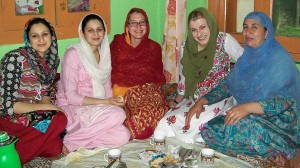 We spent an afternoon drinking chai at the home of Shahaz, who was my first real friend and the subject of one of my first blog posts. She has twin daughters; one is a school teacher and the other a dental hygienist. They talked with Anna and Mary about the ups and downs of their jobs, and were surprised to hear that the working life isn’t hassle-free in the US either! Then the talk turned, as it will, to the difficulty of finding a good man. Shahaz, suddenly inspired, turned to me and said, “I will find your daughters husbands here, if you will find American husbands for my daughters!” We all laughed.
We spent an afternoon drinking chai at the home of Shahaz, who was my first real friend and the subject of one of my first blog posts. She has twin daughters; one is a school teacher and the other a dental hygienist. They talked with Anna and Mary about the ups and downs of their jobs, and were surprised to hear that the working life isn’t hassle-free in the US either! Then the talk turned, as it will, to the difficulty of finding a good man. Shahaz, suddenly inspired, turned to me and said, “I will find your daughters husbands here, if you will find American husbands for my daughters!” We all laughed.
After a round of photos, we got ready to leave. Shahaz gave our girls big hugs and told them that, when they return to America, they shouldn’t have any worries about me. “She is my sister,” she told them. “We will take care of her. You all are our family now.”
Posted in Uncategorized by Lisa
Girls Visit: Photos with Strangers
It’s been a while since I’ve written; our daughters were here for a three-week visit, and our days together were packed with fun, adventures, long talks, and hugs. Our time together as a family provided lots of material for blog posts, but little time or concentration to write. Now I’ll catch up on some of the highlights.
Our girls’ visit had, for them, some interesting dimensions: Traveling to a new, unfamiliar place and finding it “home” for their parents. Being plopped down in a different culture and then greeted by neighbors as though they were long-lost relatives. Meeting strangers who speak an incomprehensible language and learning those strangers are “family” to their parents. Not many of their peers experience this kind of travel!
As we took our daughters to the local tourist sites, it didn’t take long for Anna to become a minor celebrity. Despite her efforts at keeping a headscarf on, her golden hair drew attention and her friendly smile invited interaction. At almost every stop, she was asked by locals to pose for photos with them, as though she were a movie star! Meanwhile, our younger daughter Mary managed to stay on the sidelines, as her dark hair and eyes enabled her to almost blend in with the crowd.
At first, all this photo-snapping was amusing, but soon we realized that we would need an extra hour at every stop if it kept up… not to mention the possibility of a photo of our daughter ending up on the internet where it shouldn’t be. So we started turning down the photo requests. But looking back, I feel happy to think of our daughter’s warm smile showing up in family photos all over the world. After all, part of our family story is making a home for ourselves on any continent, and including people from any culture in the circle of our love.
Posted in Uncategorized by Lisa
Who is Really Clean?
My husband can’t sit still.
And he’s a sucker for natural beauty.
When we arrived in North India 14 months ago, we landed in a rural community nestled in a river valley. A sweet little stream winds its way toward the river, along the road just a block from our house. It’s lined with trees, and home to 6 or 7 ducks. We walked along the stream each day on our way to and from our language class. It didn’t take long to notice that the stream was sadly cluttered with trash – plastic bags, rags, and wrappers that our neighbors upstream casually tossed into the water on a daily basis. This is traditional village-style waste disposal—you throw it into the stream and it goes away.
 My husband, who had a hard time spending his afternoons at a desk doing language study, started heading to the stream to do clean-up. Brad would wade into the water in rubber boots and gloves and toss the trash up onto the bank. Then later after it had dried out, he would return with a sharp stick in one hand and a sack in the other to collect it. He knew, of course, that he was engaged in a somewhat counter-cultural activity that would mark him as even more strange than he already was. The Muslim people we live among have strong ideas about “clean” and “dirty,” and a person who picks up other peoples’ trash would be seen not only as a potential germ-carrier, but as possibly spiritually unclean as well.
My husband, who had a hard time spending his afternoons at a desk doing language study, started heading to the stream to do clean-up. Brad would wade into the water in rubber boots and gloves and toss the trash up onto the bank. Then later after it had dried out, he would return with a sharp stick in one hand and a sack in the other to collect it. He knew, of course, that he was engaged in a somewhat counter-cultural activity that would mark him as even more strange than he already was. The Muslim people we live among have strong ideas about “clean” and “dirty,” and a person who picks up other peoples’ trash would be seen not only as a potential germ-carrier, but as possibly spiritually unclean as well.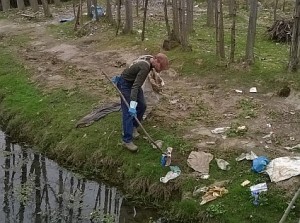
Brad learned some ways to talk about what he was doing that seemed to make sense to our neighbors. Now, as passers-by stop to watch him work in the stream, he comments on how beautiful God made this valley and how He wants us to take care of it. Sometimes he explains that honoring what God has made is a way of honoring God Himself. One of his favorite questions is, “Who is really the clean person, the person who throws trash down or the person who picks it up?”
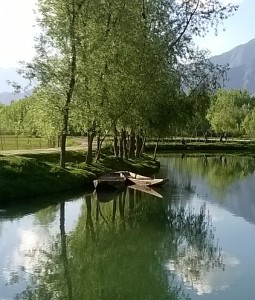 It’s hard to know if his efforts will make a difference long-term. But now there are men in the neighborhood who sometimes join him in cleaning the stream. He spoke to the students at a nearby middle-school about the importance of creation stewardship. He joined forces with the leader of the local mosque to hold a neighborhood meeting about dealing with trash. What means the most to me is the comments I hear from time to time when I visit with women, comments like, “Oh, your husband is the one who cleans the stream. He’s a good man. He will go to Heaven for sure.” They see him as someone who puts time and energy into serving the community without thought for personal gain, other than the reward of a lovely view. That’s something I’ve known about him for 30 years now, and I’m glad that our neighbors can see it.
It’s hard to know if his efforts will make a difference long-term. But now there are men in the neighborhood who sometimes join him in cleaning the stream. He spoke to the students at a nearby middle-school about the importance of creation stewardship. He joined forces with the leader of the local mosque to hold a neighborhood meeting about dealing with trash. What means the most to me is the comments I hear from time to time when I visit with women, comments like, “Oh, your husband is the one who cleans the stream. He’s a good man. He will go to Heaven for sure.” They see him as someone who puts time and energy into serving the community without thought for personal gain, other than the reward of a lovely view. That’s something I’ve known about him for 30 years now, and I’m glad that our neighbors can see it.
Posted in Uncategorized and tagged stream cleaning by Lisa
Being “Virtually” There
The big event I’m writing about today didn’t happen in India. It happened 12 time zones away, in Southern California. But thanks to modern technology, it partly happened here, too. My daughter Mary graduated from college!
At our home here in India, it was Saturday morning; and as soon as we woke up, we turned on our computer and connected to the internet. It was Friday evening in California, and the Commencement ceremony was getting underway, streamed live through multiple cameras. We sat in bed, drinking our morning coffee and eating muffins, watching it on our laptop. We listened to the speakers and eagerly waited for the awarding of the diplomas. As Mary’s name was called, she walked across the stage and received her diploma, her BA in Psychology, from the university president. Cameras followed her and recorded her big smile, and beamed it through space to our computer screen. From the audience, our other daughter was sending us her commentary via skype, and my sister was snapping photos and sending them on What’sApp. After the ceremony, we joined in the congratulations via a “live” video skype call with Mary and the family huddled around my sister’s phone.
I’m very grateful for technology today, because I don’t feel like I’ve really missed my daughter’s graduation. We are very proud of her, and of our older daughter Anna. How far they have come from our days of homeschooling, on a mat on the floor of an African mud house! They are both smart, warm, thoughtful, and fun people to be around. And most of all, loving. It somehow seems appropriate that their happy smiles and waves should be beamed instantly around the world. They are global citizens, prepared by their education, their experience, and their faith to go out and love this only world.
Posted in Uncategorized and tagged graduation by Lisa

